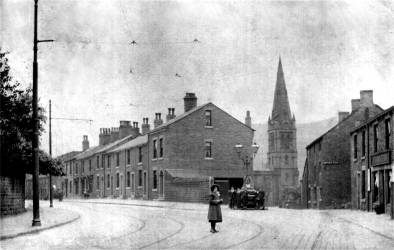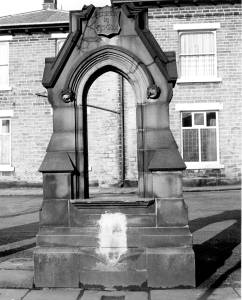The Glossop Drinking Fountains
An article in the Glossop Chronicle in October 1953 informs us that there were three drinking fountains in Glossop: in front of the Norfolk Arms, Victoria Street, and at “Turn o' t' Lane” (which the article called a lovely, expressive, descriptive street name) and that the first intimation about the fountains appear in the Council minutes for June 1880, when it was announced that Mrs. John Wood of Whitfield House was prepared to present a fountain if the council would find a suitable site. The council appointed a subcommittee of six members to make a recommendation. After five months, they recommended the site in front of the Norfolk Arms, but it was not acceptable to all of the council and the sub-committee was ordered to inspect other sites and report back again. According to the report nothing appeared (from the minutes) to have been done in the matter until February 1883, when three members were “reappointed” to be the fountains sub-committee. It would appear, then, that actions continued without being minuted.
Some 16 years earlier (23 July 1937) a previous Chronicle article, in the Watchman column, stated that the gift "must have been the first of Glossop's many benefactions, and probably the first of the number of public gifts from the Wood family".
Hamnett, in his notes on the family of John Hill Wood, wrote that Mrs. Wood made many gifts during her life, including erecting the drinking fountains, one opposite the Norfolk Arms Hotel, one at the Junction of James Street and Victoria Street, and one at the junction of Hall Street and Sheffield Road.
TW Ellison, writing in 1935 about the gifts to the town made by the Wood family told a slightly different tale, saying “Mention may also be made of previous gifts in 1881-2 of the two fountains in Victoria Street and High Street West, presented by Mrs Wood, of Whitfield House, and the fountain in High Street East by John Wood of Whitfield House”.
NOTE: John Hill Wood married Emma, the oldest daughter of William Sidebottom of Etherow House, Hollingworth, in 1854. The John Wood mentioned by Ellison was their son. There are more details of the family on the Wood and Hill-Wood families page.
The Sheffield Independent of 11 July 1881 reported on The Opening of a Fountain at Glossop.—"On Saturday afternoon, a handsome drinking fountain was opened in Norfolk Square, Glossop, having been presented to the borough by Mrs. Wood, of Whitfield House, Glossop. The gift was formally handed over to the Corporation, in the presence of a large number of spectators, by Mr. John Wood, who stated that it was also the intention of his mother to erect one or two other similar structures in different parts of the town. The present was accepted in suitable terms by Ald. S. Rowbottom (Deputy Mayor), and a vote of thanks was publicly presented to Mrs. Wood."
A report on gifts to Glossop, in the Sheffield Daily Telegraph of 29 April 1882, included the announcement that Mrs Wood of Whitfield House, a sister of the Mayor, was about to present to the town two more drinking fountains. Just over a year later, in The North Derbyshire & North Cheshire Advertiser and The Glossop & High Peak Herald of 4 May 1883, the report of the wedding of John Wood to Estelle Benham included an account of the decorations in Whitfield and Glossop attending the celebrations. It described the fountain at the corner of St. James’ Street as "new", indicating that it had only recently been erected. Hamnett also wrote that the Whitfield fountain was erected in 1882 by Mrs. Wood of Whitfield House.
It has been possible to find neither the exact date of opening nor the exact date of demolition of the fountain at “Turn o' t' Lane” (the junction of High Street East and Sheffield Road with Hall Street/Manor Park Road) but it was certainly the shortest lived. A report in the Chronicle in August 1945 mentioned that it was "bowled over" by a farmer "some years ago" and was never re-erected. A report in the Chronicle of 8 September 1950 says it was demolished by a bolting horse and milk float, and not re-erected because it was considered an obstruction.
The middle photo above is dated about 1920, the dates of the others being unknown (but between 1903 and 1927 given the presence of the trams).
In October 1953 Glossop Council wanted the owners of the fountain in Whitfield to demolish it on the grounds (according to Alderman Doyle) that it was dangerous. The Chronicle thought it somewhat strange that the council should approach the owners, saying that since the fountains were given to them, the owners should be the Mayor, Aldermen and Burgesses.
Another suggestion was that, as it had been a landmark in the past, it might be moved elsewhere, possibly into the centre of the town, placing floral decorations round it and seats nearby so that it could be an attraction for the town.
In the event no move came about and the fountain was demolished shortly afterwards.
The middle of the three photos shows the location of the fountain at the junction of Victoria Street and James Street, whilst the others show it with its original surround of railings and without them at the time its demolition was under discussion.
The Norfolk Square fountain (which had a tap above the trough with a bronze cup attached for people to drink from, a trough for horses and a smaller lower trough for dogs) is the only surviving one, though it was threatened with demolition on a number of occasions. The July 1937 article mentioned above commented on the fact that when the fountain was erected all road transport was horse-drawn and cattle fairs were held in Norfolk Square, so that it was no uncommon sight to see draught horses and cattle drinking there. By that date, however, it was rare to see a horse or beast watered at the fountain, the water being mostly used for filling up the radiators of motor buses.
In April 1944 the Glossop District Trades Council received a complaint that the fountain was not working (which was especially inconvenient to bus drivers wishing to top up leaky radiators). When the matter was reported to it, the Town Council replied that the supply pipe had sprung a leak but, as the war meant a shortage of materials and labour, the matter could not receive immediate attention. In the meantime it was suggested that thirsty drivers could call at the Norfolk Arms, which was open during all permitted hours!
Some fifteen months later the Chronicle's Watchman column commented on the complaints, asking whether it was appropriate to maintain the water supplies to the fountains. Watchman pointed out that the horse traffic was much lower in volume than that of the days when the fountains were erected and changes in hygiene standards opposed what was referred to as “the promiscuous use of the drinking vessel usually in position at the fountain”. The article questioned whether it was right that the bus companies could obtain free water supplies when other businesses were charged.
In 1968, as part of “Operation Springclean”, Norfolk Square was to be cleaned up. The dirty and broken fountain (second photo) was to be examined and the question of it being removed was to be considered.
Operation Springclean was a campaign, sponsored by the Civic Trust for the North-West, which took place in the first half of 1968. The aim was to clean up and brighten the whole of the North West of England, which was suffering from post-Industrial Revolution stagnation and decay.
In the event, the fountain remained in place and, after not working for many years, was even restored to working order in July 1995. The fabric of the fountain was also restored in 2008 after it was hit by a car (final photo).
The fountain no longer works (and, given the hygiene question, may well never do so again) but still exists to remind us of the philanthropy of one of the major mill owning families of Glossop towards the end of the 19th century.
Return to GJH.me Home Page, Return to Glossop Area Local Histories index.
Last updated: 2 March 2024












